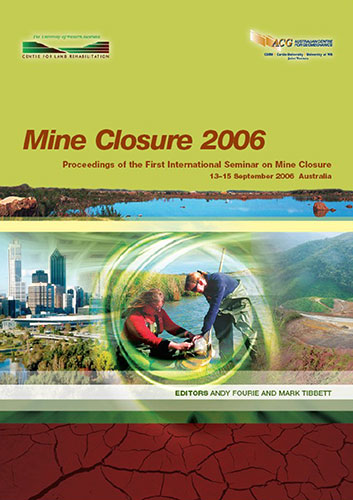Towards a Climate Based Risk Assessment of Land Rehabilitation

|
Authors: Hinz, C; McGrath, GS; Hearman, AJ Paper is not available for download Contact Us |
DOI https://doi.org/10.36487/ACG_repo/605_33
Cite As:
Hinz, C, McGrath, GS & Hearman, AJ 2006, 'Towards a Climate Based Risk Assessment of Land Rehabilitation', in AB Fourie & M Tibbett (eds), Mine Closure 2006: Proceedings of the First International Seminar on Mine Closure, Australian Centre for Geomechanics, Perth, pp. 407-415, https://doi.org/10.36487/ACG_repo/605_33
Abstract:
Successful rehabilitation of mined land is one of the key concerns for mine closures. Disturbance through mining is often so severe that rehabilitation must be viewed as the first step towards a long term evolution of the landscape and the ecosystem to a stable state that is in harmony with the surrounding land. To ensure that the rehabilitation measures will create a stable and sustainable landform, risk assessment needs to be carried out for the initial phase of rehabilitation, which may cover a time span of the first two decades depending on climate, soil and vegetation. This initial, short term assessment should also be complemented by long term risk assessment extending beyond decades. The first years after rehabilitation are the most vulnerable to extreme weather events, especially for rock dumps and tailing storage facilities that involve the design of a new landform along with placement of soil material on the surfaces. It is often a single infrequent event such as a cyclone that causes excessive erosion and potentially significant leaching events contributing to acid mine drainage. This high risk period during these first years of rehabilitation is due to immature vegetation establishment and soil development. Understanding and quantifying water redistribution on mined landforms and rehabilitated dumps and tailing dams is therefore the key to risk assessment of rehabilitation success. One of the first order controls of water redistribution is climate and in particular rainfall. While great effort has been placed on the use of detailed mechanistic understanding of small scale processes to predict and model surface runoff, infiltration, erosion and water movement in soils and rock dumps, little attention has been placed on climate forcing. In this paper we will outline a generic analysis on how the stochastic and episodic nature of rainfall contributes to the triggering of significant hydrological events that may cause damage to land rehabilitation and hence will provide us with a risk assessment tool. The analysis will focus on short term (years to decades) risk assessment aspects, as long term stability can only be realistically assessed when rehabilitation has been shown to be successful in the short term. We therefore promote a probabilistic event based approach that uses a minimalist description of hydrological processes and accurate and detailed information on rainfall as this is the most important first-order control of triggering relevant hydrological processes. We will use surface runoff as an example of our approach. This analysis will be further complemented by an analysis of the rainfall resolution required to predict surface runoff.
References:
Bronstert, A. and Bardossy, A. (2003) Uncertainty of runoff modelling at the hillslope scale due to temporal variations
of rainfall intensity, Physics and Chemistry of the Earth, 28, pp. 283-288.
Hearman, A.J. and Hinz, C. (2006) Sensitivity of point scale runoff predictions to rainfall resolution. submitted to
Hydrology and Earth System Sciences.
Hipsy, M.R., Sivapalan, M. and Menabde, M. (2003) A risk-based approach to the design of rural water supply
catchments across Western Australia, Hydrological Sciences, 48(5), pp. 709-727.
Jakeman, A.J. and Hornberger, G.M. (1993) How much complexity is warranted in a rainfall-runoff model? Water
Resources Research, 29, pp. 2637–2649.
Kirchner, J.W. (2006) Getting the right answers for the right reasons: Linking measurements, analyses, and models to
McGrath, G.S., Hinz, C. and Sivapalan, M. (2006) Temporal dynamics of hydrological threshold events, submitted to
Hydrology and Earth System Sciences.
Lehmann, P., Hinz, C., McGrath, G., Tromp-van Meerveld, H.J. and McDonnell, J.J. (2006) Rainfall threshold for
hillslope outflow: An emergent property of flow pathway connectivity, submitted to Hydrology and Earth
System Sciences.
Menabde, M. and Sivapalan, M. (2000) Modeling of rainfall time series and extremes using bounded random cascades
and Levy-stable distributions, Water Resources Research, 36(11), pp. 3293-3300.
Milly, P.C.D. (1993) An analytic solution of the stochastic storage problem applicable to soil-water, Water Resources
Research, 29, pp. 3755–3758.
Milly, P.C.D. (1994) Climate, interseasonal storage of soil water and the annual water balance, Advances in Water
Resources, 17, pp. 19-24.
Minasny, B. and McBratney, A.B. (2002) Uncertainty analysis for pedotransfer functions. Eur J Soil Sci; 53, pp. 417-
429.
Pappenberger, F. and Beven, K.J. (2006) Ignorance is bliss: Or seven reasons not to use uncertainty analysis, Water
Rodriguez-Iturbe, I., Porporato, A., Ridolfi, L., Isham, V. and Cox, D.R. (1999) Probabilistic modelling of water
balance at a point: the role of climate, soil and vegetation. Proc. Roy. Soc. London Series A – Math. Phys. and
Eng. Sci.,455, pp. 3789–3805.
Struthers, I., Hinz, C. and Sivapalan, M. (2006a) Conceptual examination of climate-soil controls upon rainfall
partitioning in an open-fractured soil. II. Response to a population of storms. Advances in Water Resources (in
press).
Struthers, I., Sivapalan, M. and Hinz, C. (2006b) Conceptual examination of climate-soil controls upon rainfall
partitioning in an open-fractured soil. I. Single storm response. Advances in Water Resources (in press).
Tromp-van Meerveld, H.J. and McDonnell, J.J. (2006) Threshold relations in subsurface stormflow 2. The fill and spill
Hydrology of Post-Mining Landscapes
Mine Closure 2006, Perth, Australia 415
© Copyright 2025, Australian Centre for Geomechanics (ACG), The University of Western Australia. All rights reserved.
View copyright/legal information
Please direct any queries or error reports to repository-acg@uwa.edu.au
View copyright/legal information
Please direct any queries or error reports to repository-acg@uwa.edu.au